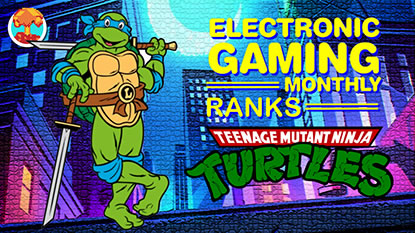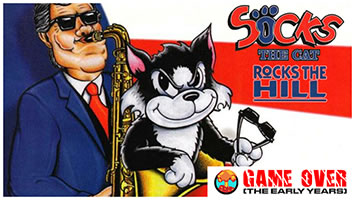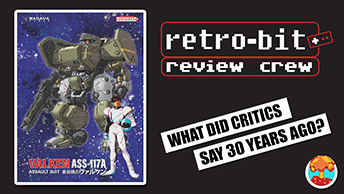- CLASSIC MAGAZINES
- REVIEW CREW
A show recapping what critics thought back
when classic games first came out! - NEXT GENERATION'S BEST & WORST
From the worst 1-star reviews to the best
5-stars can offer, this is Next Generation! - NINTENDO POWER (ARCHIVE)
Experience a variety of shows looking at the
often baffling history of Nintendo Power! - MAGAZINE RETROSPECTIVE
We're looking at the absolutely true history of
some of the most iconic game magazines ever! - SUPER PLAY'S TOP 600
The longest and most ambitious Super NES
countdown on the internet! - THEY SAID WHAT?
Debunking predictions and gossip found
in classic video game magazines! - NEXT GENERATION UNCOVERED
Cyril is back in this spin-off series, featuring the
cover critic review the art of Next Generation! - HARDCORE GAMER MAGAZING (PDF ISSUES)
Download all 36 issues of Hardcore Gamer
Magazine and relive the fun in PDF form!
- REVIEW CREW
- ELECTRONIC GAMING MONTHLY
- ELECTRONIC GAMING MONTHLY RANKS
From Mario to Sonic to Street Fighter, EGM
ranks classic game franchises and consoles! - ELECTRONIC GAMING MONTHLY BEST & WORST
Counting down EGM’s best and worst reviews
going year by year, from 1989 – 2009! - ELECTRONIC GAMING BEST & WORST AWARDS
11-part video series chronicling the ups and
downs of EGM’s Best & Worst Awards!
- ELECTRONIC GAMING MONTHLY RANKS
- GAME HISTORY
- GAME OVER: STORY BREAKDOWNS
Long-running series breaking down game
stories and analyzing their endings! - A BRIEF HISTORY OF GAMING w/ [NAME HERE]
Real history presented in a fun and pithy
format from a variety of game historians! - THE BLACK SHEEP
A series looking back at the black sheep
entries in popular game franchises! - INSTANT EXPERT
Everything you could possibly want to know
about a wide variety of gaming topics! - FREEZE FRAME
When something familiar happens in the games
industry, we're there to take a picture! - I'VE GOT YOUR NUMBER
Learn real video game history through a series
of number-themed episodes, starting at zero! - GREAT MOMENTS IN BAD ACTING
A joyous celebration of some of gaming's
absolute worst voice acting!
- GAME OVER: STORY BREAKDOWNS
- POPULAR SHOWS
- DG NEWS w/ LORNE RISELEY
Newsman Lorne Riseley hosts a regular
series looking at the hottest gaming news! - REVIEW REWIND
Cyril replays a game he reviewed 10+ years
ago to see if he got it right or wrong! - ON-RUNNING FEUDS
Defunct Games' longest-running show, with
editorials, observations and other fun oddities! - DEFUNCT GAMES QUIZ (ARCHIVE)
From online quizzes to game shows, we're
putting your video game knowledge to the test!- QUIZ: ONLINE PASS
Take a weekly quiz to see how well you know
the news and current gaming events! - QUIZ: KNOW THE GAME
One-on-one quiz show where contestants
find out if they actually know classic games! - QUIZ: THE LEADERBOARD
Can you guess the game based on the classic
review? Find out with The Leaderboard!
- QUIZ: ONLINE PASS
- DEFUNCT GAMES VS.
Cyril and the Defunct Games staff isn't afraid
to choose their favorite games and more! - CYRIL READS WORLDS OF POWER
Defunct Games recreates classic game
novelizations through the audio book format!
- DG NEWS w/ LORNE RISELEY
- COMEDY
- GAME EXPECTANCY
How long will your favorite hero live? We crunch
the numbers in this series about dying! - VIDEO GAME ADVICE
Famous game characters answer real personal
advice questions with a humorous slant! - FAKE GAMES: GUERILLA SCRAPBOOK
A long-running series about fake games and
the people who love them (covers included)! - WORST GAME EVER
A contest that attempts to create the worst
video game ever made, complete with covers! - LEVEL 1 STORIES
Literature based on the first stages of some
of your favorite classic video games! - THE COVER CRITIC
One of Defunct Games' earliest shows, Cover
Critic digs up some of the worst box art ever! - COMMERCIAL BREAK
Take a trip through some of the best and
worst video game advertisements of all time! - COMIC BOOK MODS
You've never seen comics like this before.
A curious mix of rewritten video game comics!
- GAME EXPECTANCY
- SERIES ARCHIVE
- NINTENDO SWITCH ONLINE ARCHIVE
A regularly-updated list of every Nintendo
Switch Online release, plus links to review! - PLAYSTATION PLUS CLASSIC ARCHIVE
A comprehensive list of every PlayStation
Plus classic release, including links! - RETRO-BIT PUBLISHING ARCHIVE
A regularly-updated list of every Retro-Bit
game released! - REVIEW MARATHONS w/ ADAM WALLACE
Join critic Adam Wallace as he takes us on a
classic review marathon with different themes!- DEFUNCT GAMES GOLF CLUB
Adam Wallace takes to the links to slice his way
through 72 classic golf game reviews! - 007 IN PIXELS
Adam Wallace takes on the world's greatest spy
as he reviews 15 weeks of James Bond games! - A SALUTE TO VAMPIRES
Adam Wallace is sinking his teeth into a series
covering Castlevania, BloodRayne and more! - CAPCOM'S CURSE
Adam Wallace is celebrating 13 days of Halloween
with a line-up of Capcom's scariest games! - THE FALL OF SUPERMAN
Adam Wallace is a man of steel for playing
some of the absolute worst Superman games! - THE 31 GAMES OF HALLOWEEN
Adam Wallace spends every day of October afraid
as he reviews some of the scariest games ever! - 12 WEEKS OF STAR TREK
Adam Wallace boldly goes where no critic has
gone before in this Star Trek marathon!
- DEFUNCT GAMES GOLF CLUB
- DAYS OF CHRISTMAS (ARCHIVE)
Annual holiday series with themed-episodes
that date all the way back to 2001!- 2015: 30 Ridiculous Retro Rumors
- 2014: 29 Magazines of Christmas
- 2013: 29 Questionable Power-Ups of Christmas
- 2012: 34 Theme Songs of Christmas
- 2011: 32 Game Endings of Christmas
- 2010: 31 Bonus Levels of Christmas
- 2009: 30 Genres of Christmas
- 2008: 29 Controls of Christmas
- 2007: 34 Cliches of Christmas
- 2006: 33 Consoles of Christmas
- 2005: 32 Articles of Christmas
- 2004: 31 Websites of Christmas
- 2003: 29 Issues of Christmas
- 2002: 28 Years of Christmas
- 2001: 33 Days of Christmas
- NINTENDO SWITCH ONLINE ARCHIVE
- REVIEW ARCHIVE
- FULL ARCHIVE
Sega Nomad (1995)
It's time once again for Defunct Games' 33 Consoles of Christmas, your 33 part guide to the best and worst system designs of all time. Join Cyril Lachel and Chad Reinhardt as they judge 33 different game consoles based on what they think of the look. Forget about actual hardware and software, the only thing these guys care about is talking about their exterior design. Join us every day between November 23 and December 25 for a new console review!

Synopsis: After the debacle that was the Game Gear, Sega decided to give the portable market another crack. This time around they opted not to create a new portable media; instead they focused on a handheld system that could play Sega Genesis games. The Nomad is one of the few portables that has no exclusive games, instead it was there to prolong the life of the Sega Genesis brand as console gamers flooded to the Sega Saturn. Unfortunately the Nomad's success was marred by a high price tag and terrible battery life. On the other hand, while most portable game systems struggle to introduce must-own titles, the Nomad already had a huge game library with some of the best 16-bit games of all time.
Best Games: Strider, Ghouls 'N Ghosts, Phantasy Star III, Gunstar Heroes, Streets of Rage, Sonic 3, Landstalker, Vectorman, Shinobi III and so on!




Synopsis: After the debacle that was the Game Gear, Sega decided to give the portable market another crack. This time around they opted not to create a new portable media; instead they focused on a handheld system that could play Sega Genesis games. The Nomad is one of the few portables that has no exclusive games, instead it was there to prolong the life of the Sega Genesis brand as console gamers flooded to the Sega Saturn. Unfortunately the Nomad's success was marred by a high price tag and terrible battery life. On the other hand, while most portable game systems struggle to introduce must-own titles, the Nomad already had a huge game library with some of the best 16-bit games of all time.
Best Games: Strider, Ghouls 'N Ghosts, Phantasy Star III, Gunstar Heroes, Streets of Rage, Sonic 3, Landstalker, Vectorman, Shinobi III and so on!



The Nomad is my chance to contradict myself. In the past I have complained about the massive size of the Game Gear and Atari Lynx, yet the Nomad is just as large (if not larger) and I still love it. I have complained about the battery life of portables with color screens, but the Nomad is the worst offender when it comes to sucking batteries. All of the things I hated about the Lynx and the Game Gear I mysteriously love about the Nomad; it makes no sense at all. There's just something about this Sega portable that I love, and it's not the fact that I can play all of my favorite 16-bit Genesis games on the go (for about an hour). What I love the most about this portable is the way it's shaped, it may be large but it has a neat cut to it that you don't see in other game systems. The system is not really a box, one side of the system is a little smaller than the other, and the way the buttons and the screen like up is really interesting. I also love that you can plus a second control into the machine and play two players.
And that's not all; you can also plug the console right into the TV and make it work like a traditional Genesis. This may not be the most practical use for a portable, but it's the first time I've been able to do that without having to buy special equipment. I also dig the button layout, it makes playing Street Fighter II on the go a whole lot easier. One thing I don't like is that the batteries don't actually go into the console itself; instead they go into an extra box that clips onto the back of the system. Unfortunately that box is not very sturdy, and if it breaks (or you accidentally hit it) it will turn off your system. That's lame, but it's something I can live with. Personally I just use the Nomad at my office desk with the AC cable plugged in.
And that's not all; you can also plug the console right into the TV and make it work like a traditional Genesis. This may not be the most practical use for a portable, but it's the first time I've been able to do that without having to buy special equipment. I also dig the button layout, it makes playing Street Fighter II on the go a whole lot easier. One thing I don't like is that the batteries don't actually go into the console itself; instead they go into an extra box that clips onto the back of the system. Unfortunately that box is not very sturdy, and if it breaks (or you accidentally hit it) it will turn off your system. That's lame, but it's something I can live with. Personally I just use the Nomad at my office desk with the AC cable plugged in.
Wow; if the Game Gear had a more sleek, in-your-face child, it would definitely be the Nomad. The idea of a portable Genesis was a fantastic one, even if I could never afford to own it. It's the perfect size, the buttons are comfortable in my powerful, callused carpenter's hands, but the screen is oh so small. The addition of the X, Y, and Z buttons is very nice, and I don't feel that it robs the system of any needed space the way some portable button configurations can. I also like that the cartridge sticks out a little bit at the top, letting the world know how much you love DJ Boy everywhere you go. The "Nomad" logo reminds me too much of the Jaguar's tacked-on logo, which is kind of cheesy, but the last thing Sega needed to worry about at this point was the designing of a new logo. I have to say I'm impressed with this one, and if I could ever find one for sale I would totally buy it.
HOME |
CONTACT |
NOW HIRING |
WHAT IS DEFUNCT GAMES? |
NINTENDO SWITCH ONLINE |
RETRO-BIT PUBLISHING
Retro-Bit |
Switch Planet |
The Halcyon Show |
Same Name, Different Game |
Dragnix |
Press the Buttons
Game Zone Online | Hardcore Gamer | The Dreamcast Junkyard | Video Game Blogger
Dr Strife | Games For Lunch | Mondo Cool Cast | Boxed Pixels | Sega CD Universe | Gaming Trend
Game Zone Online | Hardcore Gamer | The Dreamcast Junkyard | Video Game Blogger
Dr Strife | Games For Lunch | Mondo Cool Cast | Boxed Pixels | Sega CD Universe | Gaming Trend
Copyright © 2001-2025 Defunct Games
All rights reserved. All trademarks are properties of their respective owners.
All rights reserved. All trademarks are properties of their respective owners.




























